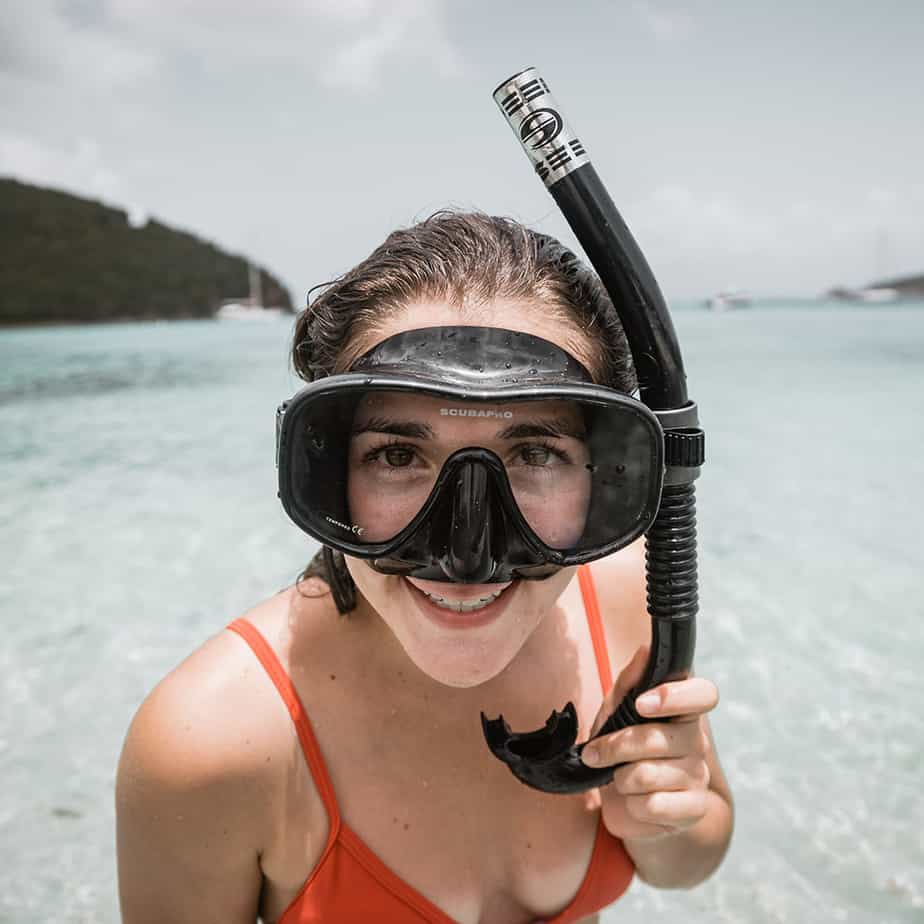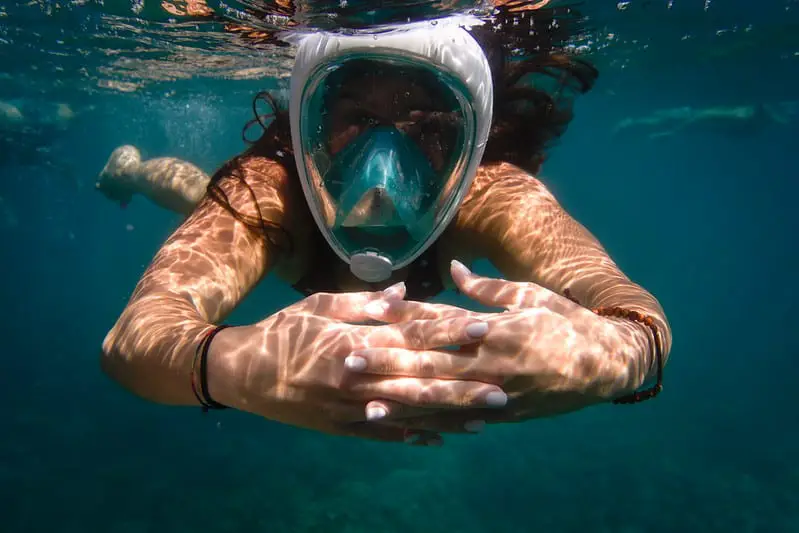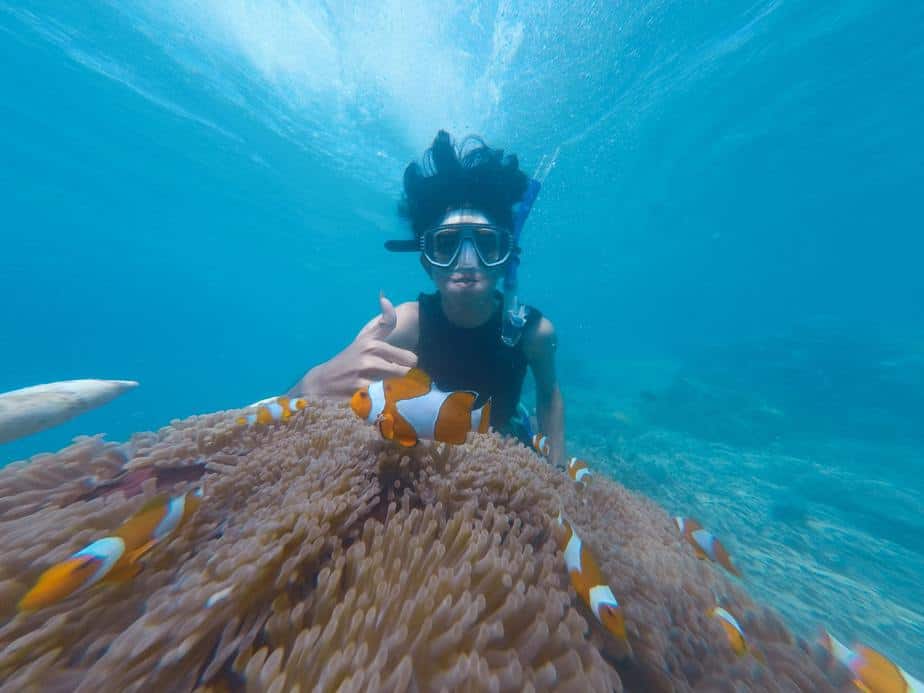Snorkeling is an affordable and accessible way for the average person to enjoy the breathtaking sights the ocean has to offer. One of the best things about snorkeling is that it doesn’t take very long for anyone to be proficient at it. However, prior to that, it can be pretty scary when water gets into your snorkel and you accidentally swallow it. Here are some tips to help beginning snorkelers get over this hump and become excellent, safe snorkelers.
Wear Properly-Fitting Equipment
One of the reasons why snorkeling is so accessible is that it doesn’t need much equipment, unlike scuba diving, for someone to get started. The only truly essential pieces of gear are the mask, snorkel, and fins, and maybe a flotation device for safety.
The starting point for where things go wrong is how they fit you. As with any sport or recreational activity, with just these few pieces of equipment, they should fit well to ensure that you are comfortable and safe.
Mouthpiece
For snorkeling, this means that the mouthpiece is made of antibacterial material that can be kept in your mouth for long periods of time without causing any fatigue or pain. Too big or small, and it will become apparent very quickly when your jaw muscles get sore.
Mask
As for your snorkeling or diving mask, how well it fits depends on how well it seals on your face. The size of the mask and your facial structure plays an important role. To give you an idea of how it should fit, the mask should be able to suction to your face on its own even without any straps.The mask strap should be worn over the broadest part of your head and it should fit snugly without digging into your skin.
A common issue that prevents the mask from forming a watertight seal on your face is hair getting in the way. Long strands of hair or facial hair such as a beard or mustache are often the culprits for a water leakage. Without a tight seal, you will have to frequently surface to clear the water.
Snorkel
Next, the snorkel should be attached to the mask with a clip or keeper. The tube will be angled at 45-degrees between the back and top of your head. When snorkeling, your face should also be pointed at 45-degrees. This will position the snorkel to stick straight out of the water. If you’re looking straight down, your snorkel will be angled and water will get in more easily.
Fins
Lastly, fins aren’t strictly necessary for snorkeling, but they do help beginners swim faster and farther with less effort. The fins should fit snug as well. Depending on the type of fin, you may need to wear a neoprene sock underneath, in which you should leave 1-2mm of space around your feet for the sock. There are various types of snorkeling fins, such as paddle fins and split fins, long fins and short fins, travel fins, scuba fins, as well as fins for wide feet.
Use A Dry or Semi-Dry Snorkel

There are three main types of snorkels: wet, dry, and semi-dry. Let’s go over each one in more detail.
A wet snorkel is the most basic type of snorkel. It’s effectively just a long tube that connects to your mask, with no special features to keep water out. You are most at risk of swallowing water when using a wet snorkel.
Next, semi-dry snorkels have a few features that can keep water from reaching your mouth. At the top end of the tube is a splash guard. This is a cover with an angled opening that keeps random splashes or rain water from entering the tube. The mouthpiece will also have a purge valve, which is a small reservoir with a one-way tube that will expel the water accumulated there before it reaches your mouth.
Lastly, dry snorkels are the crème de la crème of snorkels. If you want to snorkel without swallowing water, get yourself a dry snorkel. It has everything a semi-dry snorkel has with the addition of a float valve. This is yet another mechanism located at the tube opening which can completely seal the tube shut if the snorkel gets submerged. Float valves will prevent water from flooding into your mouth.
Which one to use?
As you’d expect, wet snorkels are the cheapest and lowest-quality, whereas semi-dry and dry snorkels are more expensive and reliable. Wet snorkels are outclassed by their dry and semi-dry counterparts and should not even be a consideration. Beginners who do not want to choke on water should use some kind of dry or semi-dry snorkel.
With that said, there is a downside to dry snorkels, particularly the float valve mechanism. In some rare cases, the float valve gets stuck in the fully sealed position. This means that fresh air can’t enter, which can cause beginners to panic because they suddenly can’t inhale. You can dislodge the float valve by shaking it, but you’ll have to surface to do so. For this reason, semi-dry snorkels may be the most reliable option.
Stay Calm
The first time you snorkel is a harrowing experience. You will not be used to breathing underwater, and will have to condition yourself that it’s okay to inhale while submerged. We recommend you practice breathing through the snorkel before heading into the water just to get used to it.
You can even try snorkeling in a shallow pool at first, or in shallow waters close to the shore. Take deep, full breaths, and exhale fully as well. Once you’re confident that you have the technique down, you can try it in deeper waters. The key is to stay by the surface of the water, and to try not to submerge past the length of your snorkel tube where water can enter.
To help you stay calm, we recommend you wear either a snorkel vest, flotation belt, or even a life vest. Particularly if you’re not a strong swimmer, you can have peace of mind knowing that staying afloat is effortless when using one of these flotation devices. Flotation devices also help you conserve energy so even if you’re a strong swimmer, you can benefit from wearing one.
When you do end up swallowing and choking on water (which can happen because even dry snorkels aren’t perfect) it is crucial that you stay calm. Going into a full-on panic and thrashing around is only going to worsen the situation. This is why wearing a flotation device is so helpful.
When you do swallow water, you are better equipped to handle it when you’re calm. With a flotation device, all you need to focus on is quickly lifting your head up and removing the mouthpiece so you can cough and get some fresh air.
Control Your Breathing
In a similar vein, in order to stay calm you must learn to control your breathing. You should be taking deep and slow breaths to ensure proper air exchange through the snorkel tube. Shallow breaths are detrimental because they increase the concentration of carbon dioxide lingering in the dead space of the snorkel tube.
When breathing with a snorkel, not all of the air makes it through the tube into your mouth, and neither does all the carbon dioxide leave from your mouth to the outside. When CO2 accumulates in the tube, and not all of the fresh air reaches your lungs, you may feel like you’re suffocating.
Performing deep inhales and exhales clears the tube more fully, and reduces the chances of CO2 buildup. If you find yourself getting dizzy or lightheaded, you should surface immediately to get some fresh air into your lungs. You should practice taking deep breaths on land to prepare yourself for breathing through a snorkel.
Press Your Tongue to the Roof of Your Mouth
Sometimes water will make it inside the tube and into your mouth. No water prevention method is foolproof. In anticipation of this, you can press your tongue to the top of your mouth whenever you inhale. Doing so makes your tongue act as a splash guard so that water won’t go straight down your throat. The downside of this technique is that it can easily tire out your tongue.
Wear a Full-Face Mask

An alternative to the snorkel and mask setup is to wear a full-face mask. A full-face mask covers the entire face and has a dry-snorkel built into it. The benefits of a full face mask are that you can breathe with either your mouth or nose thanks to its breathing chamber which means you don’t need a mouthpiece.
Many beginner snorkelers find full face masks to be more comfortable and easier to breathe underwater with. They don’t have to worry about jaw fatigue or the snorkel getting in the way of the mask. Also, the built-in snorkel is a high-quality dry snorkel which will keep most of the water out. Even if water does manage to enter the mask, it won’t go straight into your mouth so you won’t choke on it.
With that said, full face masks have been caught up in a bit of controversy with claims that they are dangerous. We have written our view on this controversy, which you can read about here. Our conclusion is that it’s just as safe as any other snorkel, even for kids, and therefore it is a viable alternative for people who prefer this type of mask. We review the best full face snorkel masks in our review.
Snorkel in Calm Conditions
You never know what the weather conditions are going to be like. It’s good to ask the locals about the currents for that day. If the waters are choppy, you will have more to worry about than accidentally swallowing water such as dangerous riptides. Consider going snorkeling on a different day if the weather condition is not fair.
First time snorkelers should practice in confined bodies of water such as a swimming pool or lake. This way, they can be sure that there will be no unexpected waves that will pour water down their snorkel tube. Waves can also push you into sharp rocks or coral, so they can truly be a hazard.
When you are feeling confident to brave the waters, do so on a warm and sunny day. Warm water will provide a more relaxing experience. Colder water will require more gear such as a wetsuit to keep you warm.
Head Positioning
Many beginners make the mistake of looking straight down while snorkeling. This is not the optimal head position. Your head should be positioned 45 degrees upwards. This will position your snorkel optimally so that it is perpendicular to the surface of the water. If you’re looking straight down, the snorkel will be slanted and the tube opening will be a lot closer to the water, increasing the likelihood of water entering.
Clearing Your Snorkel
Let’s say water managed to get inside the snorkel tube. Now what? There are two ways to purge the snorkel.
The first way is the most straightforward. Simply remove the snorkel from your mouth and shake out the excess water. Beginners may find this to be easier, but the downside is that you have to surface in order to do this, interrupting your snorkeling experience.
The second way is to forcefully exhale to purge the water from the tube. This tactic can be done if the snorkel has a purge valve. The purge valve is a one-way valve located at the bottom of a small water reservoir in the mouthpiece. Water that makes it down the tube accumulates in this reservoir. When you forcefully exhale, the water is forced out of this one way valve. You can do this without having to surface.
Parting Words
Learning how to snorkel without swallowing water seems tricky at first, but with some practice and the help of a dry snorkel, you can easily accomplish it. You can drastically decrease the chance of choking on water or getting a sore throat by following the proper techniques and using the appropriate snorkeling gear.
The better you get at snorkeling, the less likely you’ll get water in your snorkel. Soon, the only thing you’ll be taking in are the beautiful sights the underwater world has to offer, not a mouthful of water.


